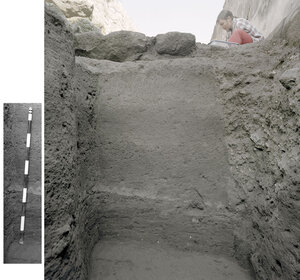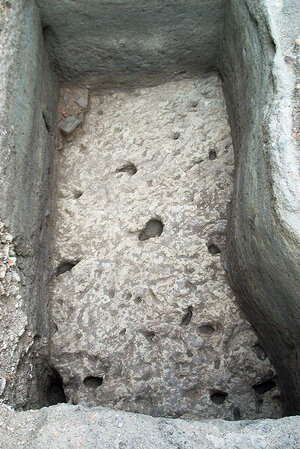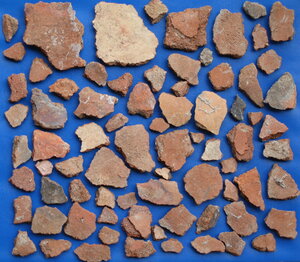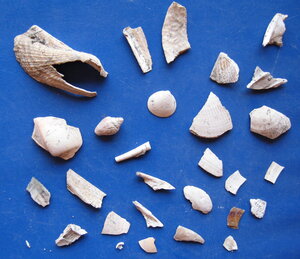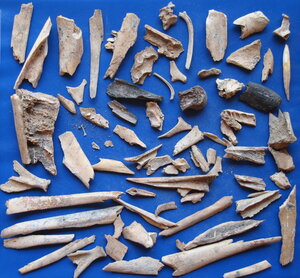Prehistoric settlements
Bronze Age occupancy
The earliest remains of human settlement in the area of Insula V 1 dates to the Early Bronze Age Palma Campania culture, confirmed by a radiocarbon analysis dating to 1890-1690 BC. Finds from this period were first discovered in the shaft of a well, situated in the n-e corner of room f of V 1,13. This discovery let to a small scale (approx. 2 m2) excavation under the small street viccolo delle Nozze d’Argento just north of V 1,13. This excavation showed remains of two layers of early bronze age settlements. They both belong to the same early Bronze Age phase, but are separated by a layer of volcanic debris, that according to earth analysis stems not from a Vesuvian but from a Campo flegreian eruption. In the upper layer, in the southwestern corner, part of a structure was unveiled, probably a hearth. It is built of stones and pottery-sherds, more fragile than the finds of the contemporaneous layer that surrounded it.
“The results of the excavation far exceeded our expectations: literally thousands of finds were collected - the total number of prehistoric pottery sherds exceeded 3,500 and their combined weight was close to 20 kg. The prehistoric animals identified by C. Liebe-Harkort among the collected bones include cattle, sheep/goat, pig, rodent, bird and pig while M. Robinson has identified barley grain, glumes and grain of emmer wheat and possibly the glumes of spelt wheat from the carbonized plant material. There were many other types of finds collected during the course of the excavation, including lumps of clay, stones and numerous soil samples. These may appear insignificant, but add information to our theories that the site was a permanent settlement and that it was, at least before the Early Bronze Age seismic event, next to either the sea shore or a river. It is evident that the inhabitants survived the volcanic ash fall and that they used the site without clearing the ground from ashes, but the toxic properties of volcanic emissions may still have caused their delayed demise or voluntary abandonment of the settlement.”
“The nature of these remains demonstrates that the site was permanently settled: there is a high density of finds; there is evidence of processed grain; there is a range of pottery-types for both storage and serving; and there is the fact that, although the pottery is in bad condition, many pieces fit together and did not simply come out of a heap of discarded refuse or from eroded material.”
A similar sequence of stratigraphies with two layers from the early Bronze Age, separated by a thin layer of volcanic debris, was detected during excavations (Carried out in cooperation with prof. M. Robinson, Oxford University) in the peristyle garden of the nearby Casa degli Epigrammi Grecci. These were found in the south-east corner of the garden, containing sherds from the Palma Campania culture and probably some remains of a undefined structure.
These results, pointing towards quite extensive human activity in the early bronze age period in Pompeii, were later confirmed by finds from beneath Insula IX 12 , Insula VIII 4, or beneath Insula VII 13, Insula V 3, V 4 and V 5.
Iron age occupancy
At the excavation in the peristyle garden i of the Casa degli Epigrammi grecci also some pottery sherds from the Iron Age were found in a pit, indicating some human presence also for that period, but no remains of any structures or features related to it were discovered. (Robinson 2009, 128). These can probably be dated to a period between the middle of the 9th and the middle of the 7th century B.C.

